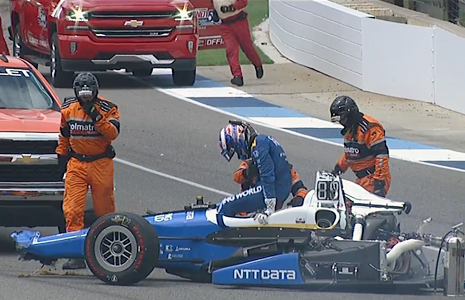INDYCAR safety innovations shine again at Indy 500
MAY 29, 2017
It was one of those accidents that makes everyone hold their breath.
Fifty-three laps into the 101st Running of the Indianapolis 500 presented by PennGrade Motor Oil on Sunday, Jay Howard got into the marbles and agonizingly slipped up the banking in Turn 1 until he hit the Indianapolis Motor Speedway wall. Luckily for Howard, it's covered by the SAFER Barrier, which dissipated most of the impact force as designed.
It all looked fairly innocuous until Howard's No. 77 Lucas Oil/Team One Cure Honda drifted down the track and onto the racing line as cars streamed past at more then 200 mph. Tony Kanaan (No. 10 NTT Data Honda) just missed Howard, but teammate Scott Dixon wasn't as fortunate.
The 2008 Indy 500 winner couldn't avoid the stricken car and the No. 9 Camping World Honda's right front tire hit Howard's left rear, which launched Dixon skyward.
The car flew for about three seconds and roughly 200 yards, while making a half turn in the air and flipping on its side. It landed on the top of the SAFER Barrier on the inside of the track, striking the foam with its left sidepod before spinning down the wall at least five times. It finally came to rest in Turn 2.
“I'm just a little beaten up; it was definitely a bit of a rough ride,” Dixon said.
“Big thanks to Dallara and everybody for the safety standards that we have right now. It was a wild ride, man, and you just hold on. It makes you believe in the safety of these cars and the progress they've made.”
 Like all incidents in the Verizon IndyCar Series, the first on the scene was the Holmatro Safety Team, which travels to all races and handles all car recovery in the series.
Like all incidents in the Verizon IndyCar Series, the first on the scene was the Holmatro Safety Team, which travels to all races and handles all car recovery in the series.
The damage to Dixon's car was catastrophic: pretty much everything behind the driver was gone, the front wing had been ripped off, only the left front wheel remained, and the right sidepod was gone. Oddly, the right-side mirror survived the ordeal. The Dallara chassis' safety cell that protects the driver did its job and Dixon was able to get out unaided and head to the track’s IU Health Emergency Medical Center, where he checked out fine.
Howard also walked away and had praise for the safety measures after being released from the infield hospital.
“I'm fine and credit to INDYCAR, the Indianapolis Motor Speedway and Holmatro Safety Team and Dallara, everybody who was involved in doing this car,” Howard said. “I'm fine thinks to them and I am really glad Scott is OK.”
The fact that bruises were the biggest injury in a terrifying incident is a testament to the SAFER Barrier developed by Dr. Dean Sicking and a team of engineers two decades ago at the University of Nebraska’s Midwest Roadside Safety Facility.
SAFER stands for Steel And Foam Energy Reduction, which essentially describes the structure of the device. It is a foam barrier mounted on a steel skeleton with more foam sections behind. All combine to absorb energy in accidents and help reduce the forces transferred to the car and driver.
But the SAFER Barrier first installed at Indianapolis Motor Speedway 15 years ago isn't the only thing that helped Dixon. He also wears a Head and Neck Support device, commonly known as HANS, invented by Dr. Robert Hubbard of Michigan State University. It keeps the head from snapping around during violent accidents and can prevent deadly basal skull fractures.
On top of it all, the Dallara IR-12 chassis used by the Verizon IndyCar Series also has a driver-protecting safety cell and energy-absorbing foam that increase the likelihood that drivers get a clean bill of health from the medical center following any incident.
Then again, sometimes drivers still get hurt even with all the safety measures.
On May 20, Sebastian Bourdais made a mistake and veered into the SAFER Barrier in Turn 2 at about 227 mph — a force of 100 times gravity (100Gs) — but escaped the qualifying accident with a fractured hip and pelvis from the seatbelts. Amazingly, the Holmatro Safety Team was at Bourdais' car and helping him within 10 seconds of it coming to rest on the track.
The No. 18 GEICO Honda driver underwent surgery and walked out of the hospital just four days later. He gave credit to the safety innovations at the speedway and in the car he drives.
“The car did a really good job head-on,” he explained. “I don’t think there are a lot of people who can say they have survived a head-on crash at 227 mph. I don’t know that everybody knows, but I was still full throttle when I hit the wall. It’s a pretty good testament (to the safety measures).”
While it's impossible to know how many drivers are alive today because of the SAFER Barrier, HANS and the advances in car design, ask any driver and they'll tell you it's probably saved them from serious injury at least once.






















